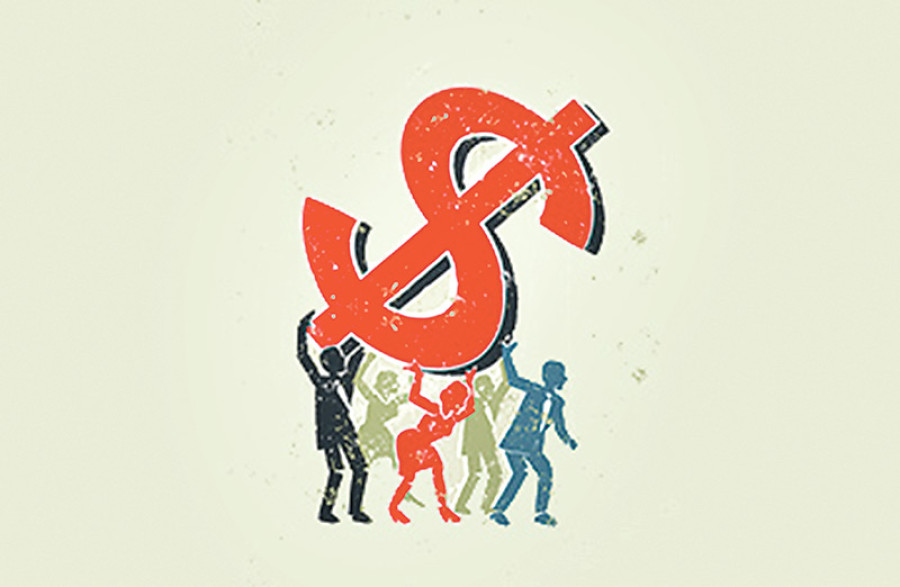Opinion
Go easy on the spending
The government of Nepal granted formal recognition to remittance in 1985 with the enactment of the Foreign Employment Act.
Gunakar Bhatta
The government of Nepal granted formal recognition to remittance in 1985 with the enactment of the Foreign Employment Act. This act was superseded by a new one in 2007. The Eighth Plan 1992-97 recognised the importance of foreign employment and started exploring additional avenues. Currently, Nepal has allowed its citizens to go to work in 110 countries. The outflow of foreign jobseekers that started after the restoration of democracy in 1990 turned into a flood in 1994 after the country was engulfed in a civil war. In 1998, the government started issuing passports from the district administration offices, which significantly eased the movement of Nepali workers. Departures jumped from 4,000 in 1993-94 to 500,000 in 2014-15.
Remittance has been playing a key role in keeping the Nepali economy running smoothly. Annual remittance inflow has remained at 27.7 percent of the GDP for the last five years, thanks to the more than 3 million migrant workers toiling away in varied lands and sending money home. Currently, Nepal holds foreign exchange reserves sufficient to cover imports of goods and services for 11 months. Moreover, remittance has increased national savings and reduced poverty, besides helping migrant workers to acquire new skills abroad and apply them at home. Remittance has also contributed significantly to raising government revenue. In the last five years, imports soared 115 percent, pushing up the government’s income from import duty by 164 percent. Imports, mainly financed by ever-increasing remittance, have helped to swell the state coffers.
Redistributed resources increasing import
Even though Nepal has benefitted much from remittance, there are also challenges emanating from overreliance on money sent home from abroad. Particularly, the risk of Dutch disease is on the rise. Dutch disease is linked to the resource curse, the transmission channels of which are generally linked to the resource distribution effect and the spending effect.
Currently, the resource distribution effect is reflected in the lack of farm workers and increasing acreage of abandoned land in the hilly region. This situation is turning Nepal into a food importer. The country’s rice imports have been increasing annually, from Rs16 billion in 2014-15 to Rs22 billion in 2015-16 and Rs24 billion in 2016-17. Similarly, Nepal is buying soybean oil, edible oil, vegetables, baby food, milk products, fruits, spices, live animals and many other food items which could have been produced at home. Farmers in the Nepali hills are trading soybean for salt or noodles. The soybean is processed abroad and exported to Nepal. This is an example of the absurdity in our market system where we are exporting labour and raw materials and importing daily essentials.
Can we continue to spend?
The spending effect of remittance can be seen in the distressing rise in the import of private motor vehicles and oil. Likewise, the travel spending of Nepalis has also been escalating unprecedentedly. Such spending totalled Rs56 billion in 2015-16. In one year, the figure ballooned to Rs80 billion. Even local colleges are paying huge sums in the form of affiliation fees to international universities. Despite the presence of universities and world class curriculum at home, Nepal has been remitting huge fees to international universities just for the use of their name. A question that naturally arises is whether Nepal can keep spending so much money. These are just a few examples which show how remittance money has instigated the spending effect.
Recent remittance data point to a worrisome scenario ahead. Even though the Rs2 billion drop in remittance in the first four months of 2017-18 compared to the same period of the previous year is not a big sum, it is a warning signal. Will we cut back on consumption if remittance goes into a downward trend? Will imports of petroleum products and food products follow a reverse trend? Will we be able to hold back our travel and tourism exposure abroad? If not, resource distribution and the spending effect of remittance will plunge the country into Dutch disease.
Further, what will happen to bank lending even to priority sectors when the deposit base shrinks? Moreover, the hue and cry over a fall in the share index will have no meaning when our banks fall short of liquidity. Despite the benefits we have reaped from remittance over the years, the time has come to think about alternatives. Ongoing developments on the fiscal and external fronts suggest that the gap between remittance inflow and imports will be becoming wider. Nevertheless, immediate priority should be given to fixing leaks by channelling remittance through the banking system besides exploring areas in managing imports.
Bhatta is the director of the research department of Nepal Rastra Bank




 12.12°C Kathmandu
12.12°C Kathmandu










